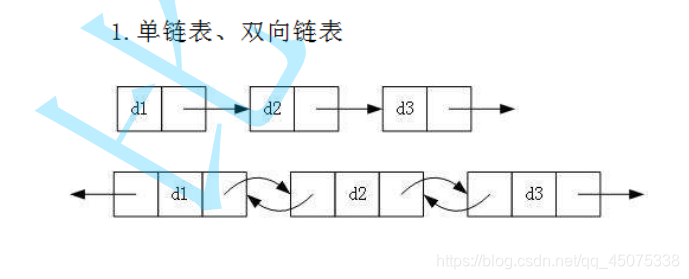链表是什么?
链表是一种物理存储结构上非连续存储结构,数据元素的逻辑顺序是通过链表中的引用链接次序实现的 。
实际中链表的结构非常多样,以下情况组合起来就有8种链表结构:
单向、双向
带头、不带头
循环、非循环



虽然有这么多的链表的结构,但是我们重点掌握两种:
无头单向非循环链表:结构简单,一般不会单独用来存数据。实际中更多是作为其他数据结构的子结构,如哈
希桶、图的邻接表等等。另外这种结构在笔试面试中出现很多。
无头双向链表:在Java的集合框架库中LinkedList底层实现就是无头双向循环链表。
链表实现
class LinkedNode{
public int data;
public LinkedNode next = null;
public LinkedNode(int data) {
this.data = data;
}
}
public class LinkedList {
private LinkedNode head = null;
public void display() { //打印链表
System.out.print("[");
for (LinkedNode cur = head; cur != null; cur = cur.next) {
if (cur.next == null) {
System.out.print(cur.data);
} else {
System.out.print(cur.data + ",");
}
}
System.out.println("]");
}
public void addFirst(int elem) { //头插法
LinkedNode node = new LinkedNode(elem);
if (this.head == null) { //空链表清况
this.head = node;
return;
}
//不是空链表清况
node.next = head;
this.head = node;
}
public void addLast(int elem) { //尾插法
LinkedNode node = new LinkedNode(elem);
if (this.head == null) {
head = node;
return;
}
LinkedNode cur = this.head;
while (cur.next != null) {
cur = cur.next;
}
cur.next = node;
}
//任意位置插入,第一个数据节点为0号下标
public boolean addIndex(int index, int elem) {
int len = size();
if (index < 0 || index > len) {
return false;
}
if (index == 0) { //插头部
addFirst(elem);
return true;
}
if (index == len) { //插尾部
addLast(elem);
return true;
}
//插任意位置 重要的是肯定需要找到他前一个位置
LinkedNode node = new LinkedNode(elem);
LinkedNode cur = this.head;
int i = 0;
while (i < index - 1) {
cur = cur.next;
i++;
}
node.next = cur.next;
cur.next = node;
return true;
}
//查找是否包含关键字key是否在单链表当中
public boolean contains(int key) {
if (this.head == null) { //空链表
return false;
}
LinkedNode cur = this.head; //不是空链表进行遍历
while (cur != null) {
if (cur.data == key) {
return true;
}
cur = cur.next;
}
return false;
}
//删除第一次出现关键字为key的节点
public void remove(int key) {
if (this.head == null) {
System.out.println("链表为空,无法删除");
return;
}
if (this.head != null && this.head.data == key) {
this.head = head.next;
return;
}
LinkedNode cur = this.head; //遍历找到那一个结点如果有这个结点则去把他前一个结点表示出来
while (cur != null) {
if(cur.next == null){ //防止越界 上面的cur.next.data越界
break;
}
if (cur.next.data == key) {
cur.next = cur.next.next;
System.out.println("删除成功");
return;
}
cur = cur.next;
}
System.out.println("无这个结点");
return;
}
//删除所有值为key的节点
public void removeAllKey(int key) {
if (this.head == null) {
System.out.println("链表为空,无法删除");
return;
}
while (this.head != null && this.head.data == key) { //删头结点
this.head = head.next;
}
LinkedNode cur = this.head;
while (cur != null) { //遍历找到那一个结点如果有这个结点则去把他前一个结点表示出来
if(cur.next == null){ //防止越界 上面的cur.next.data越界
break;
}
if (cur.next.data == key) {
cur.next = cur.next.next;
}
else { //防止出现连续数 则cur不往后遍历还在原地继续删除后面的数
cur = cur.next;
}
}
System.out.println("无这个结点");
}
//得到单链表的长度
public int size() {
int size = 0;
LinkedNode cur = this.head;
while (cur != null) {
size++;
cur = cur.next;
}
return size;
}
//清空链表
public void clear(){
this.head = null;
}
public static void main(String[] args) {
}
}
用另一类来检验一下
public class ListTest {
public static void main(String[] args) {
LinkedList headlist = new LinkedList();
headlist.addLast(2);
headlist.addFirst(2);
headlist.addLast(2);
headlist.addLast(5);
System.out.println(headlist.addIndex(2,3));
System.out.println(headlist.contains(1));
headlist.display();
headlist.remove(3);
headlist.addLast(4);
headlist.addLast(4);
headlist.addLast(4);
headlist.display();
headlist.removeAllKey(2);
headlist.display();
System.out.println(headlist.size());
headlist.clear();
headlist.display();
}
}
链表要学会理解引用是什么,还有(x.next)到底指向谁,而且增添改删在链表中极易实现,重要要找到其要操作的前一个结点,而且在添加结点一定要先连右边,再连左边。防止覆盖或丢失。





















 734
734











 被折叠的 条评论
为什么被折叠?
被折叠的 条评论
为什么被折叠?








